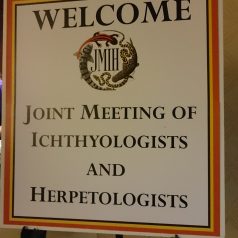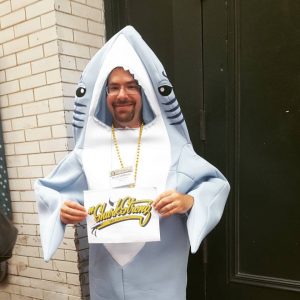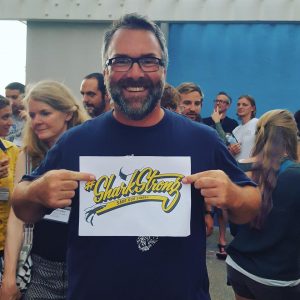
In the week of July 5-10, American shark and ray experts came together for the annual meeting of the American Elasmobranch Society (AES). This conference is organized every year as part of the Joint Meeting of Ichthyologists and Herpetologists (JMIH) and took place in New Orleans, Louisiana. Dr. Paddy Walker presented the Save Our Sharks project of the DCNA to the American colleagues. She outlined the science and policy objectives of the project, gathering valuable input from colleagues, and opportunities for regional cooperation.
By attending the conference, the Save Our Sharks campaign was introduced to a great number of experts in the field of shark biology, ecology, and fisheries, leading to valuable contacts and relevant input on the scientific component of the project. And especially great to see was how some of the most well-known expert colleagues were willing to show their support for the campaign by posing with the Shark Strong hashtag.

David Shiffman (@WhySharksMatter) 
Dr. Neil Hammerschlag (University of Miami) and Dr. Tristan Guttridge (Bimini Shark Lab) 
Michael Scholl (Save Our Seas Foundation) 
Rob Stewart (Sharkwater)
The meeting was officially opened on Wednesday by an absolutely inspiring keynote address from the queen of the deep herself, miss Sylvia Earl. She spoke about the developments in the world of natural science with regard to gender equality and technological progress. Growing up along the coast, and having a lifetime of experience exploring the underwater world, Sylvia Earl personally witnessed the devastating effect human actions have had on the marine environment over the past decades. As a first leader of an all-female team of aquanauts, she made many groundbreaking discoveries and has been on the forefront of the marine conservation movement. One particularly generous gesture was the fact that she declined the honorary she was offered to come speak, making this money available for extra student bursaries and the student travel fund.
Throughout the first three days of talks, we learned how juvenile mako sharks dive down to lower depths in the middle of the day, that within a system, larger shark species do not necessarily feed at a higher trophic level, and that a custom build release cage may help reduce immediate mortality for Cuban Dogfish after bringing them up for tagging. A multitude of presentations regarded studies using BRUVs, which are used for sharks in the Dutch Caribbean as well. Another major topic is the use of satellite tagging, which one team even uses to assess fisheries mortality of sharks.
Examples of genetic topics range from population assessments of American coastal shark species to the application of genetics in species determination on the market. Management and policy topics also covered a broad spectrum, from the effect of CITES listing on species conservation status to the advances in American fisheries management, and an identification of global priority actions for shark conservation. Some particularly interesting new revelations concerned the effect of shark loss on coral reef fishes and the phylogeny of manta rays and devil rays.
The final day of the AES meeting was a Sawfish Symposium, with speakers from nine different countries, covering research from 14 countries. The takeaway message of the symposium was that the Sawfish is in serious trouble, but it is getting an increasing amount of attention, and conservation action. Unfortunately, the Smalltooth Sawfish is considered locally extinct in the Dutch Caribbean. Yet, in the Wider Caribbean region, research and conservation measures can still contribute to improving the status of the Critically Endangered species. In 2017, the meeting of the American Elasmobranch Society will be held in Austin, Texas.
By Linda Planthof





